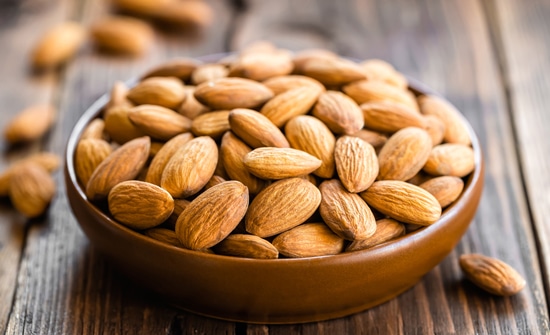TRIBE Nutritional Scientist Dr Tamsyn Forsyth tells us all we need to know about protein - the super-nutrient of the moment. Eating enough protein is important for everyone, whether you want to eat more healthily, or help recover from your workouts.

Protein is a BIG topic of conversation at the moment, and deservedly so as chemically speaking, proteins are by far the most structurally complex and functionally sophisticated molecules known.[1] We are all aware that protein is an essential component of our everyday diets, but where do protein shakes fit in? Are they just for bodybuilders, or can they form a beneficial component of our daily lifestyles?
The role of protein in the body
Protein forms the basis of living tissues and is a vital part of our bodies’ everyday functioning, whether we are pounding the streets, sweating it out at hot yoga, or sitting on the sofa watching a film. As well as being the major structural component of muscle and other tissues in the body, proteins play a central role in many biological processes by providing us with hormones, enzymes (which catalyse, or speed up, metabolic reactions), and haemoglobin, the transporter of oxygen. Although not the primary choice as an energy source, our bodies also use proteins to support survival under more extreme situations.
Protein is continually turning over
There are many thousands of different proteins in every cell in the body. These proteins are continually broken down and renewed in a process known as ‘turnover’, which is very important in maintaining cellular homeostasis (or balance). Protein turnover allows the body to degrade proteins that are damaged and not functioning properly (protein breakdown), and replace them with new functional proteins that have been synthesised (protein synthesis). The rate of protein turnover varies between different types of proteins and, compared to tissues such as the stomach and liver, skeletal muscle protein turnover is a relatively slow metabolic process. It also allows the relative amounts of different proteins in a cell to change in response to altered demands or changes in the environment, such as changes in nutritional and physiological conditions. The overall rates of protein synthesis and protein degradation in our tissues change to meet the continuously changing demands that our bodies encounter, such as growth, development, health and illness.
So, how are new proteins made?
Introducing the amino acids
New proteins are synthesised from building blocks called amino acids, or AAs, of which there are 20 in total. Each type of protein is formed from a unique sequence of amino acids, which link together by forming peptide bonds to create the long chains we know as polypeptides. Functional proteins are formed from one or more polypeptide chains, which precisely fold up to form a specific, complex shape that is unique to each type of protein and critical to its function.
Cells contain free amino acids (known as the amino acid pool), and it is these free amino acids that are used to make new proteins. As would be expected, the size of this pool depends on how many amino acids are put in, and how many are taken out. Amino acids are taken out of this pool in two ways, one is to synthesise new proteins, and the second when they are broken down. Amino acids are added to this pool when they are synthesised by the body, when protein is broken down, and from the intake of protein in our daily diets.
Unlike glucose and fatty acids, there are no specialised forms of storage for amino acids (or proteins) in the body that can be called upon to contribute to the amino acid pool. Note that although protein itself can’t be stored, it can be converted to other storable components such as glucose (and then glycogen). What this means is that our bodies require a relatively constant source of all 20 amino acids to maintain normal metabolism, which brings us to a very important point – the difference between amino acids that are produced by the body and those that are supplied in our dietary protein.
Non-essential vs. essential amino acids
The body can synthesise 11 of the 20 amino acids itself; however, it can’t make the remaining nine. The good news is that we can source these nine through our diets as animal and/or plant protein. The 11 amino acids the body can synthesise are known as non-essential amino acids (NEAAs), whereas the nine it can’t are called essential amino acids (EAAs).
Some foods contain all nine of the essential amino acids, for example eggs, milk and soy, and these are often referred to as ‘complete’ proteins. As well as essential amino acids, dietary protein contains non-essential amino acids, a dietary source of which is also important for helping to achieve optimal health.[2]
Let’s turn our attention to skeletal muscles
Skeletal muscles make up nearly 60% of our total body protein.[3] Skeletal muscle is a dynamic tissue and, as explained earlier, muscle protein is in a constant state of turnover. The rate of protein turnover varies between different tissues and, compared to the stomach and liver, skeletal muscle protein turnover is a relatively slow metabolic process. The balance between protein synthesis and protein breakdown is known as net protein balance (or NPB), and when this is equal our muscle mass is maintained. If the rate of muscle protein synthesis exceeds protein breakdown, the muscle is in a state of positive net protein balance and this is known as the ‘anabolic’ state. When the reverse happens, and the balance is shifted to a negative protein balance, this is referred to as the ‘catabolic’ state.
Earlier I talked about the rates of protein synthesis and protein degradation in our tissues changing in response to demands that are placed upon it. For skeletal muscle, these demands range from being in our control (for example, our level of dietary protein), to not in our control (for example, starvation).
How does dietary protein affect muscle protein turnover?
The stimulation of muscle protein synthesis is believed to be the main factor responsible for regulating the maintenance or a gain in skeletal muscle mass.[4] Dietary protein is one of the two main stimuli (the other is physical activity) that can affect muscle protein synthesis. Individual amino acids that are produced when dietary proteins are metabolised (broken down) serve as building blocks for the production of new muscle proteins, and they also act as signalling molecules to stimulate muscle protein synthesis. One of the nine essential amino acids – leucine, which is known as a branched chain amino acid – is particularly important in stimulating muscle protein synthesis.
It’s worth pointing out here that essential amino acids are required to synthesise proteins in many other parts of the body beyond skeletal muscles, for example methionine is important to healthy maintenance and growth of our hair and nails, highlighting the importance of our dietary protein.
Essentially, if one of the nine essential amino acids is lacking or absent from our diets, the ability of muscle to be maintained, repaired or to grow is likely to be compromised.[5] This highlights the importance of eating a variety of high quality protein sources. The quality of a protein depends on two factors: 1) the overall ‘profile’ or composition of amino acids that are contained within the protein, and 2) the proportion of these amino acids that is effectively digested and absorbed in the body to become available in a form that the body can use (known as protein digestibility).
The timing of protein intake is important
If you lead an active lifestyle and exercise regularly, whether recreationally or more seriously, eating the right amount of protein at the right times is important for promoting general health and workout performance.
As might be expected, the stimulatory muscle protein synthesis response to dietary protein intake doesn’t last forever.[4] This is why, ideally, daily protein intake should be achieved by consuming protein at regular intervals throughout the course of the day.[4,6] This helps to maximise daily muscle protein synthesis both at rest and after exercise.[4] For example, the rate of skeletal muscle protein synthesis in healthy adults is reported to be 25% higher when protein intake is evenly distributed across breakfast, lunch, and dinner, compared with consuming most of your daily protein at the evening meal, despite the same overall daily intake of total protein.[7]
Two key time points where protein intake is believed to be influential to our general health and skeletal muscle protein turnover are breakfast and post-workout. While it’s possible to obtain daily protein requirements by eating whole foods, supplementing with products such as protein shakes can help ensure you are consuming a sufficient amount of high-quality protein, while minimising your calorie intake at the same time.[6]

Breakfast
What we eat at breakfast is an important consideration for our metabolic health8 – i.e., the health of the biochemical processes that are involved in our body's normal functioning. A breakfast higher in protein can lead to beneficial metabolic effects, for example by replacing rapidly-available carbohydrates and high glycaemic index/glycaemic load foods, which can result in lower glucose and insulin responses, and increased satiety (feeling of fullness).[8]
Post-workout
The period of time immediately after exercise is often considered the most critical part of nutrient timing.[6,9] Protein supplementation during this time may help to offset muscle damage and promote recovery by re-building any damaged muscle fibres through stimulation of muscle protein synthesis. A systematic review on the effects of protein supplements on muscle damage, soreness and recovery of muscle function and physical performance found that beneficial effects such as reduced muscle soreness and markers of muscle damage become more evident when protein supplementation is consumed after daily training sessions.[10]
How much protein is right for you?
Eating enough protein is important for everyone, whether you want to eat more healthily, gain muscle mass, lose weight, or help recover from your workouts. Some people need more protein than others, and the amount depends on factors such as your age, weight, and level of activity. The recommended protein requirement for a normal adult is 0.75 grams (g) per kilogram (kg) of bodyweight (bw) per day.[11] This means if you weigh 65 kg, your protein intake should equate to 48.75g of protein per day. However, this guidance is for the general population and is enough to prevent deficiency in the majority of people. If you are physically active, a regular gym goer, or in training, it is highly likely you will need more than this.
For people who lead a relatively active lifestyle, the International Society of Sports Nutrition (ISSN) recommend an overall daily protein intake in the range of 1.4–2.0g protein per kg bw per day for the majority of active people, to maintain or build muscle mass through a positive muscle protein balance.[12] For a 65 kg person, this is equivalent to 91–130g of protein per day.

What does this mean in terms of food?
The protein levels (grams [g] per serving size) of some everyday foods are listed below:11
1 chicken breast (grilled; medium sized 130g) = 42g of protein
2 medium sized eggs (100g) = 13g of protein
Greek style plain yogurt (small pot 120g) = 7g of protein
Almonds (100g) = 21g of protein
1 glass of soy milk (250 ml) = 8g of protein[13]

If you haven’t done so already, check out the new TRIBE protein shakes. Each serving delivers 20 grams of complete protein from plant-based sources in 3 delicious flavours, perfect for a breakfast smoothie or post-adventure recovery!

Written by TRIBE Nutritional Scientist Dr Tamsyn Forsyth
References
The literature sources:
- Alberts B, Johnson A, Lewis J, et al. Molecular Biology of the Cell. 6th edition. Garland Science; 2014. Chapter 3 Proteins; The Shape and Structure of Proteins.
- Hou Y, Yin Y, Wu G. Dietary essentiality of “nutritionally non-essential amino acids” for animals and humans. Exp Biol Med (Maywood) 2015;240(8):997–1007.
- Poortmans, JR, Carpentier A, Pereira-Lancha LO, Lancha, Jr. A. Protein turnover, amino acid requirements and recommendations for athletes and active populations. Braz J Med Biol Res 2012; 45(10):875–890.
- van Vliet S, Burd NA, van Loon L. The Skeletal Muscle Anabolic Response to Plant- versus Animal-Based Protein Consumption. J Nutr 2015;145(9):1981–1991.
- Hoffman JR, Falvo MJ. Protein – Which is Best? J Sports Sci Med 2004;3(3):118–130.
- Kerksick CM, Arent S, Schoenfeld BJ, et al. International society of sports nutrition position stand: nutrient timing. J Int Soc Sports Nutr 2017;14:33.
- Wu G. Dietary protein intake and human health. Food Funct 2016;7(3):1251–1265.
- Maki KC, Phillips-Eakley AK, Smith KN. The Effects of Breakfast Consumption and Composition on Metabolic Wellness with a Focus on Carbohydrate Metabolism. Adv Nutr 2016;;7(3):613S–621S.
- Aragon AA, Schoenfeld BJ. Nutrient timing revisited: is there a post-exercise anabolic window? J Int Soc Sports Nutr 2013;29;10(1):5.
- Pasiakos SM, Lieberman HR, McLellan TM. Effects of protein supplements on muscle damage, soreness and recovery of muscle function and physical performance: a systematic review. Sports Med 2014;44(5):655–670.
- British Nutrition Foundation. Nutrition for Sport and Exercise. Protein. Available at: https://www.nutrition.org.uk/healthyliving/an-active-lifestyle/eating-for-sport-and-exercise.html?limit=1&start=2 Last accessed September 2017.
- Jäger R, Kerksick CM, Campbell BI, et al. International Society of Sports Nutrition Position Stand: protein and exercise. J Int Soc Sports Nutr 2017;14:20.
- British Heart Foundation. What you really need to know about milk. Available at: https://www.bhf.org.uk/heart-matters-magazine/nutrition/milk Last accessed September 2017.
